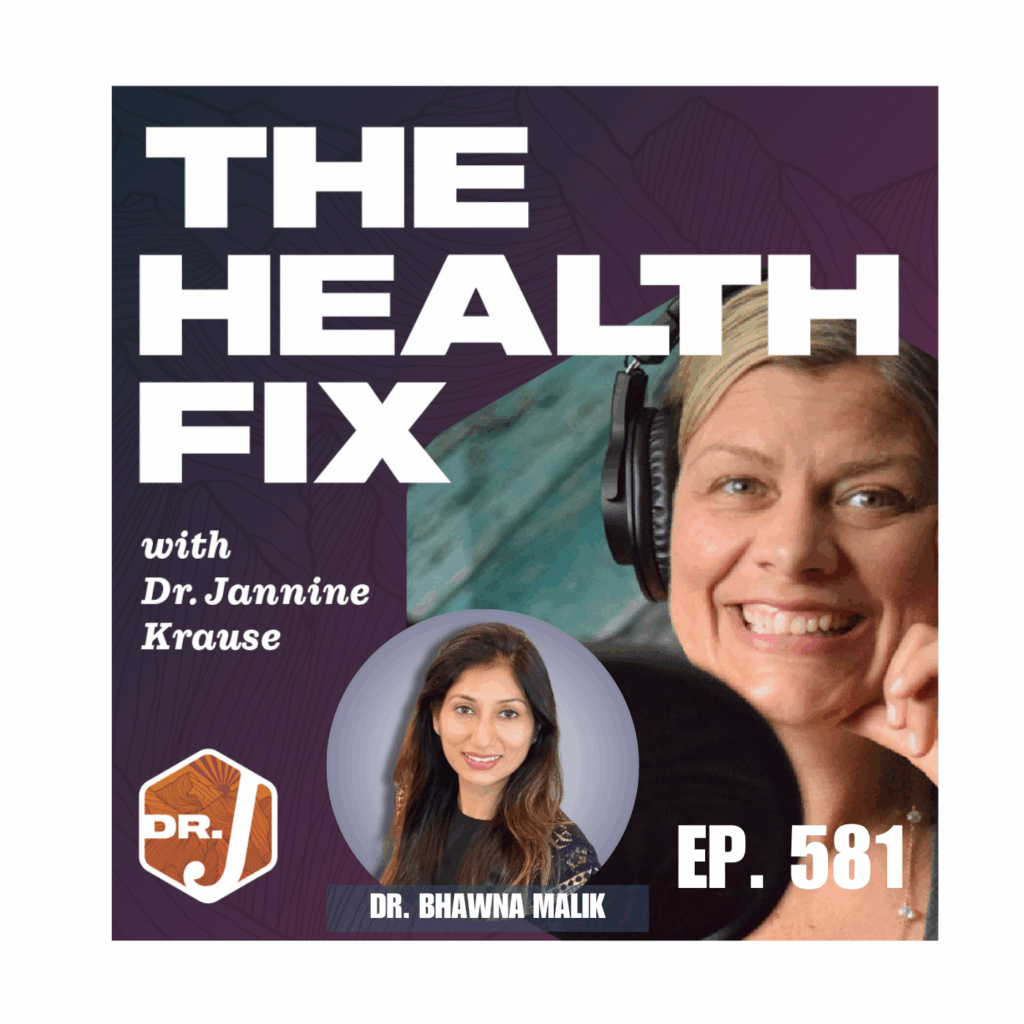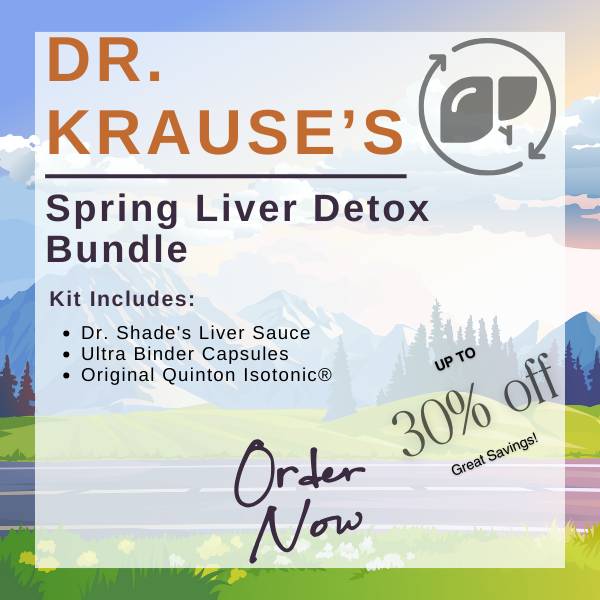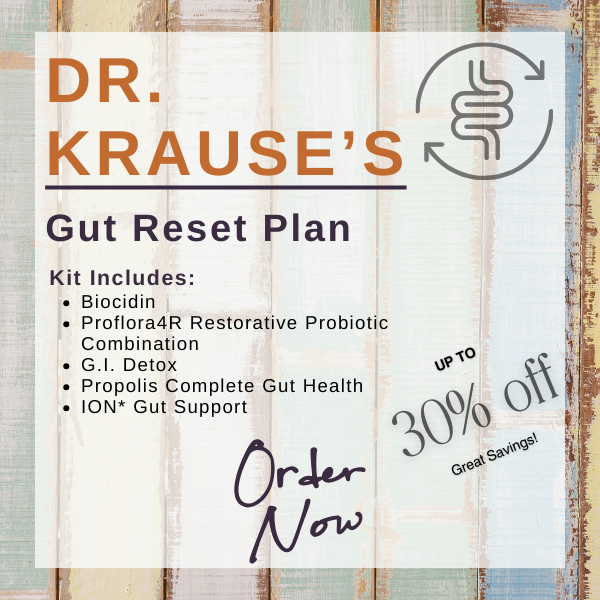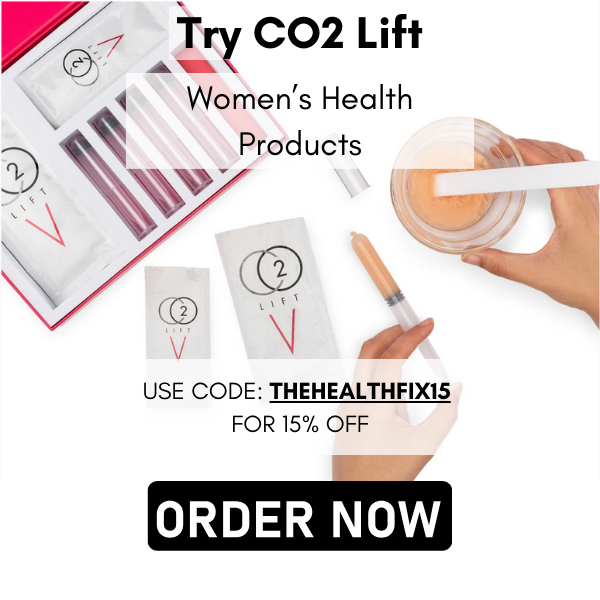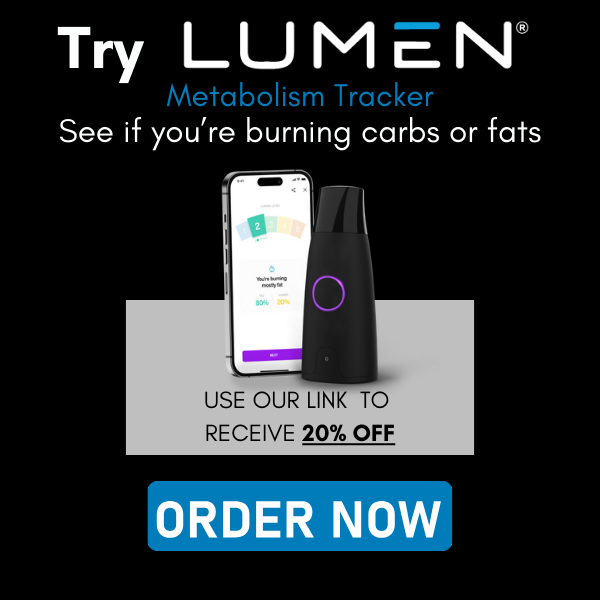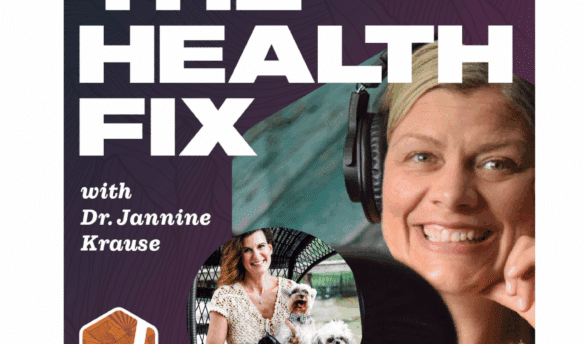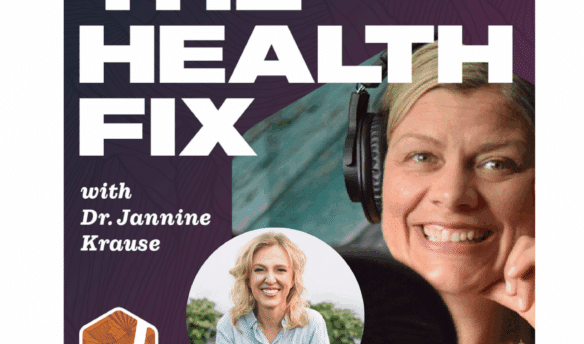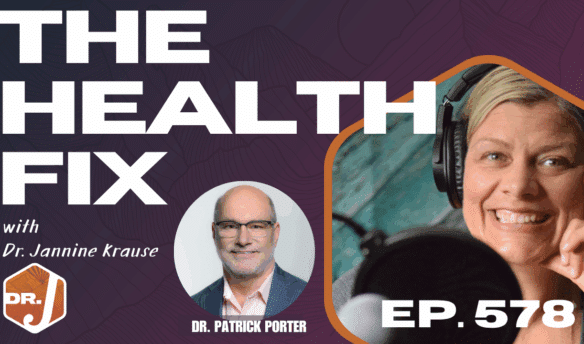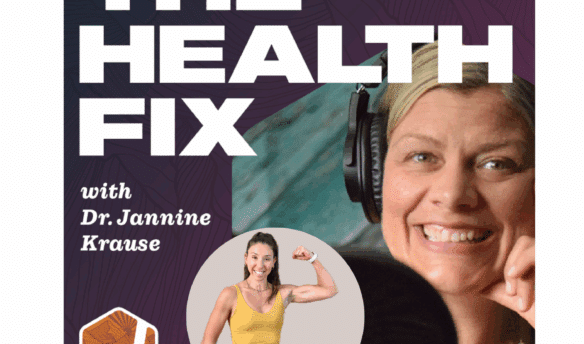Can your pelvic floor tell you something about your stress levels?
Is there a real connection between your heart, brain, gut, and hormones?
In this episode of The Health Fix Podcast, Dr. Jannine Krause sits down with Dr. Bhawna Malik, a pelvic floor physical therapist with over a decade of experience specializing in fertility and women’s health, to explore the powerful link between pelvic health and heart-brain coherence.
Whether you’re planning for pregnancy, navigating perimenopause, or simply wanting to age well this episode is packed with tools and insights for every woman at every stage of life.
Dr. Krause’s Protocols
Instructions Included
Traveling soon? Looking to detox or reset your gut? Try one of Dr. Krause’s Fullscript plans.
💡 Key Topics Covered:
- The mind-body connection: Pelvic floor + Heart-Brain coherence
- How trauma and stress affect pelvic health
- The pelvic floor’s cyclical changes throughout the menstrual cycle
- Why pelvic awareness is key at any age
- Supporting fertility naturally through breathwork and mindfulness
- The gut-heart-hormone connection and how it impacts your health
- Tools to regulate stress and balance hormones naturally
- Using HRV (Heart Rate Variability) as a wellness marker
🎯 Top Takeaways:
- Stress and trauma are often stored in the pelvic floor, leading to dysfunction and imbalance.
- Creating heart-brain coherence through breath and mindfulness helps reset the nervous system.
- The pelvic floor changes with your cycle being aware of symptom shifts is key.
- Fertility and hormonal balance are impacted by gut health, nervous system regulation, and movement.
- Heart Rate Variability (HRV) is a powerful indicator of your nervous system and hormone health.
🔥 Power Quotes:
🗣️ “The nervous system, pelvic floor, and heart-brain coherence are deeply interconnected.”
🗣️ “Mobility is essential for pelvic health and overall well-being.”
🗣️ “You can’t support your hormones without regulating your stress.”
⏱️ Chapters / Timestamps:
0:00 – Welcome & Intro to Dr. Bhawna Malik
10:00 – How stress & trauma show up in the pelvic floor
20:00 – Movement, mobility & cycle-based pelvic awareness
30:00 – Gut health, nutrition & hormone support
40:00 – Heart coherence, HRV, and stress regulation tools
50:00 – What every woman should know about pelvic health
🌿 Connect with Dr. Bhawna Malik:
👩⚕️ Connect with Dr. Jannine Krause:
🌐 Website
🎧 The Health Fix Podcast
📸 Instagram
📣 SHARE THIS EPISODE!
Know a woman trying to conceive, dealing with hormonal issues, or feeling disconnected from her body?
Our Partners
Podcast Transcript
Chapters
00:00 Exploring Pelvic Health and Heart Coherence
03:10 The Impact of Trauma on the Body
06:04 The Connection Between Gut Health and Pelvic Floor
09:19 Movement and Mobility in Pelvic Health
12:18 Fertility and Nutrition: A Holistic Approach
15:10 Cycle Syncing: Aligning Health with Menstrual Phases
25:53 Understanding Heart Rate Variability
34:01 Techniques for Achieving Heart Coherence
41:42 The Impact of Focus on Health Outcomes
47:56 Bridging the Gap in Women’s Health
50:26 Outro THFP 2022.mp3
Jannine Krause (00:02.082)
Dr. Bhawna Malik, welcome to the Health Fix Podcast.
Dr. Bhawna Malik (00:05.556)
Thank you so much for having me, Jannine. Pleasure to be here.
Jannine Krause (00:08.974)
Well, we’ve had some fun already on Instagram going live and so I have no doubt that in our conversations previously, we are going to have a good conversation today. So, of course we’re talking pelvic health, we’re talking about heart coherence. A lot of people probably wouldn’t put those two things together. What was the process of you figuring out like, wow, these things go really well together? How did you learn about it? How did it come together? Give us a scoop.
Dr. Bhawna Malik (00:36.646)
Absolutely. So my work as pelvic floor physical therapist led me to a lot of diagnosis and different women of all ages really, but working with them, it came to a point where there was this common thread and more often than not stress, how they were carrying that stress in their bodies, especially the pelvic floor, their ability to relax or not relax rather was
determining a lot of the issues that they were having with the pelvic floor, be it difficulty with urination, pain during sex, or just tightness overall.
All of these symptoms are just like a little tip of the iceberg, but there is so much more that goes on into that. And that’s when the heart-brain coherence, ability to relax the muscles on command, because we are supposed to. And if there is pain, too much pain happening during the menstrual cycle, during sex, none of that is normal. If there is leakage happening during laughing, sneezing, that’s not normal.
So these are all the common threads and pieces that brought us to, okay, these are really, really the three pillars, if you will, where the nervous system, the pelvic floor, and heart-brain coherence go together.
Jannine Krause (02:07.064)
That makes sense. That makes sense. And you know, think a lot of people at this point, you know, it seems anyway, have seen heart coherence or learned about the nervous system. And probably the biggest thing that that’s kind of brought that to everyone’s attention is the open conversation of trauma and trauma stuck in the body and things of that nature. Can you speak a little bit to trauma stuck in pelvic floor, hips, that area? Perhaps you can twist it towards a little bit of the shock.
for those folks that are under, know, well, let’s see, well-versed is probably a good word in those departments. Give us a little bit of background there in terms of how you’ve addressed that with different folks.
Dr. Bhawna Malik (02:49.16)
Yes, and I’m so glad you brought this up. Generally speaking, I wouldn’t go into chakras just because I love to speak about science, but the truth is that in our, we call it first energy center, where the sacral plexus, a lot of neurons are meeting up.
Jannine Krause (02:56.558)
Thank
Dr. Bhawna Malik (03:10.496)
So many neurons are meeting up to that one center where it’s informing the brain about what is going on. And when I say what is going on, it means whether or not your body is either in the sympathetic or parasympathetic at a time. so then depending on what signals are coming from that sacral plexus or that pelvic floor region, the brain makes the decision of what types of hormones to now release and then circulate in the
bloodstream. And there is so much research that’s now coming out, like I said, with the trauma being stored in the body that this is really very, clear that there is a very close connection and it’s really so close that we can’t separate the two. are together, they go together. So unless there are steps taken to address that and then heal and release whatever it is that needs to be processed,
the body can’t function as it was meant to be.
Jannine Krause (04:14.83)
That sense. That makes sense. Well…
know, one of the other things along with trauma that I tend to see is the digestive system will tend to interfere with the pelvic floor. And a lot of folks who have constipation in my practice, I will often say, hey, have you seen a pelvic floor? Physical therapists, mean, same goes with diarrhea and abdominal pain. I’ve even found that if folks work on their pelvic floor and they have diverticulitis, I’ve seen some change. So I’m guessing in the field of working with fertility along with folks that have
digestive issues, you’ve probably seen a little bit of connection between all of those things. Fertility, gut, gut health, prolific floor. Give us a little background there.
Dr. Bhawna Malik (04:58.9)
Big connection actually. So the constipation is, I would say, to 99 % of the time, that’s how common it is when people are having pelvic floor issues. And there’s a very good reason because right above the sacral plexus that I talked about is your gut and all of the neurons are meeting now there to form the next plexus on that chain and then informing again with the nervous system.
and taking the directions and communicating. Gut health, again, in the trauma is deep rooted in the body. And just like the pelvic floor, the body does not feel safe in those two energy centers when there is trauma present. And that is why when we change, you know,
the approach, when we address the root cause, when we start to work with the hardened brain coherence, we can undo years of trauma that was stored in the body using breath work, using hardened brain coherence techniques. There is also quick coherence techniques for folks who have busy schedules and the lifestyle and whatnot. there are ways to address and first thing is to become aware of what it
feels like in the body because if people are so busy and going about with their lives they sometimes don’t even they’re so disconnected that they don’t even know that if they’re feeling that yucky feeling in the stomach and the gut in the you know more lower let’s say pelvic floor region
What does it mean? And why are they having it? And then how to address it actually, which is part two, which comes later once they have learned the tools and techniques. But prior to that, just being aware of what they’re feeling is not normal. shouldn’t happen. And then they actually have some control over changing that. yeah, nervous system plays a humongous role in detecting the types of signals that these two centers are producing.
Dr. Bhawna Malik (07:12.167)
and then communicating back to these systems.
Jannine Krause (07:17.282)
think a lot of people look at all of the different symptoms they might be experiencing or they’re looking at it and going, okay, how do I even start? What’s one of the ways that you have folks starting to track their symptoms? Do you have like people writing out on a journal? What do you do or how do you recommend exploring the symptoms and when they show up and helping you keep track?
Dr. Bhawna Malik (07:38.546)
Yeah, so a lot of times when I’m working with women, the first hour is really deep diving into where they are coming from because two people with same age groups, same diagnosis may look totally differently based on, of course, what else is going on in their environment and how they are processing the feedback from the environment and their body and then how they are actually
responding to the environment. So that’s why that personalized approach becomes so, so important. And so there is a framework that I work with where I would look at the pelvic floor health and what’s going on there, the gut health, the nervous system, their movement. And then sort of come up with in all of these, you know, framework, what is it that they need most help with? And then we go from there. And like I said, it will look totally differently
based on what it is that’s going on in their particular life and scenario.
Jannine Krause (08:42.67)
Gotcha, gotcha. Now you mentioned movement and we had talked about this before, because obviously physical therapists specialize in pelvic floor physical therapy. So before you became a pelvic floor physical therapist, you did all the physical therapy things and you had mentioned movement. I think for a lot of people, we’re still not 100 % sure of what mobility.
in the pelvis means and you know maybe they go to a chiropractor and the chiropractor tells them they have a twisty pelvis or maybe even their physical therapist has mentioned that. How does movement play into the pelvic floor? Where do you see restrictions or where do you see you know I’m curious and also like even maybe hypermobility and like
things like Ehlers-Danlos or even in the case of a Lucy Goosy, I’m gonna call it this because this is my terminology guys, but Lucy Goosy like pelvic floor connect or not pelvic floor connection, but pubic symphonic. I can talk today, boy, pubic symphonic connection. Cause maybe they just had a baby a couple months ago, the relaxant is still active or the pubic symphonic never really seemed to come back together. That’s a long question.
Dr. Bhawna Malik (09:51.944)
Yeah, that’s a great one because that’s true. A lot of times people are not sure what movement really means. In yoga, there is a saying that you are as young as your spine.
You’re only as old or as young as your spine. And I believe that is so, so true and right on. Because again, it’s not the chronological age. It’s the biological age that makes all the difference. Two 50-year-olds can look totally differently depending on how they’re presenting. So the posture makes a difference. How they are, you know, caring themselves. The gait makes a difference.
how much mobility there is in their spine makes a difference. And these are some major, major, you know, key points. Most people, I would say, have low mobility. So, hypomobility is more common. Hypermobility is present, like you said, after pregnancy. The ligaments, there is lexity going on, and then, yeah, there’s a phase. And then sometimes in athletes where they have been used to, you know, doing certain types of movements, or it could also be by birth, right?
So so there are a small percentage of people where there is hypermobility where they you really be really want to make sure that they have more stability at that point and their muscles are strong and doing what is supposed to be because when their Joints are so loose they are prone to get injured and so that’s a different segment But talking about the hypermobility now looking at the lifestyles people after a certain age in our Western culture Lose so much motion just because the default life
that we live in. Most people are so used to sitting in the chair, couch, bed, they hardly ever sit on the floor. The pelvis doesn’t get a chance to actually get that full external and internal rotation and it presents issues and it presents issues which ties into already if someone is having let’s say difficulty or myofascial issues at the pelvic floor. Now the joint restrictions are going
Dr. Bhawna Malik (12:05.023)
to add up and then muscle restrictions which you know further pronounce the problem even more. So going back to that mobility piece what type of mobility is also important especially for pelvic floor?
is something that is not much talked about. When I say that, what I mean is that, for example, the reciprocal movement has such a big piece for our brain where when we are utilizing the opposite or these, you know, twisting and turning in a guided, gentle way, but done properly, it also communicates with the brain in a way that it lets it know that the body is
through movement. So we let the body know through breath work like we talked about earlier through heart and brain coherence but even with that rhythmic movement the brain gets informed that it is actually okay things are safe and so we can you know start to relax. I hope that answered your question.
Jannine Krause (13:15.406)
Absolutely. think for a lot of people, yes, the hypo, so lack of mobility is definitely a big deal. I see it. And like you said, we’re sitting on couches. A lot of people can’t even get up off the floor. And this is something that I used to, when I saw a lot of folks in person, I would put them through. I’d like, let’s sit on the floor for a second, and then let’s get back up, because it helps me to really see how mobility happens.
And sadly, you know, I’m seeing folks in their 40s really struggling with this and I’m going, whoa, okay, you’ve, you know, hopefully you’ve got another 40 plus years to live. This is not a good thing. We want to make sure, you know, we’re getting moving here, but not only that, hypo mobility and now pelvic floor. And we’re wondering why, you know, so many women are struggling with hormone stuff. So many women are struggling with gut stuff. It’s, you know, all.
Wildly connected. So when you see folks online, are you going through a movement analysis with them? Are you putting them through all the paces of sitting on the floor or doing whatever types of things you would you would think through?
Dr. Bhawna Malik (14:27.581)
yes, so the assessment does include looking and sort of assessing how they’re presenting, but more importantly, going by what are they coming up with, what are they listing as these are the issues that, for example, someone is having, and then breaking it down to further. yeah, movement analysis is definitely something that goes with that. so, seeing them through the lens and
is definitely something that is part of the evaluation.
Jannine Krause (15:04.086)
I find this really significant that you’re doing that because let’s face it, a lot of folks are specializing in fertility and I don’t see it happen where we look at mobility quite often. And one of like my most, I would say profound cases of helping someone with fertility when I was seeing folks in person and doing a lot of acupuncture was seeing this one gal who had incredible hip.
like restriction on the left side and also had issues with her gut too. And realizing that, you know, all of the different supplements and things we were doing to try to regulate her period and, and, you know, get a good ovulation didn’t really do the trick until we worked.
on that mobility. so this is why, of course, I really wanted to have folks talk about this. Now, another thing that you kind of had mentioned, and let’s switch towards fertility a little bit here. And I know that this probably doesn’t apply to everybody listening, but I think we can all agree that this is great information to share with the younger generation. With fertility, do you find that a lot of women come to you
on supplements, using progesterone, using hormones for, mean, aside from IVF, but looking just, or IUIs, just looking at general starting. Are people using wild yam creams? Do they come to see you with a bunch of different supplements on board and nothing’s working?
Dr. Bhawna Malik (16:31.004)
Most of them do because they’re already trying. They’ve been trying to conceive and they have so the first thing what they think of is going to the Google, going on Google and looking at the symptoms and then they come up with the supplements. Supplements, yes, for sure. Now, as I’m sure you know, the way that the supplements are in our country, there is no standardized way. So a lot of times it’s just about you can close your eyes and take anything really.
Jannine Krause (16:41.025)
Mm-hmm.
Dr. Bhawna Malik (17:01.068)
make much of a difference unless you really really know where it has been sourced, has it been tested, what’s going on and you know those details but most people don’t so yeah they do have some sort of supplements as a baseline when they reach out.
Jannine Krause (17:16.076)
Yeah. Are you are you recommending anything? Do you find that?
You know, you either have an and keep in mind we all we all know that like everyone’s individual I don’t want to like give anyone the idea that we’re saying you have to do this It’s more like do you find that there’s something that tends to be beneficial for most women? Who are struggling with pelvic floor and heart coherence? Is there anything like adaptogenic herbs magnesium? I’m just throwing out things CBD. Is there anything that seems to be a Probably a good thing to have on board. Maybe fish oil. I don’t know. I’m just throwing things
out.
Dr. Bhawna Malik (17:52.979)
Well, my number one thing is almost to look at their nutrition super, super closely and make sure that they’re at least doing the bare minimum because nothing beats just pure vegetables, fruits, water, and of course the fiber and all of those things and protein that goes into it. So just making sure that they have a full rainbow going on on their plates, which is super important. And a lot of times that’s something that they don’t even have yet. And yes, they’re taking supplements, but we really need to address that.
So yes, with the busy lives, whatever we can do is good, but just understand that it’s affecting your hormones and fertility in a bigger way than perhaps most people understand. that’s of course number one, but no, the research definitely points fingers towards some of the main supplements that make a big difference, including CoQ10, magnesium. There is also…
a prenatal, so folate acids, those tend to be really a good starting point and like I said main area of focus should always be what they’re eating in there on what’s on their plate is the biggest thing.
Jannine Krause (19:13.742)
Absolutely, absolutely. I think we can get, you know, and I’ve been there with folks and trying to support fertility in whichever way we can and yes, you know, the different supplements and it can be overwhelming. And I think, you know, we can’t supplement our way out of a poor diet that we just can’t do. So, so important to think of it that way. Now, in terms of looking at different phases of the cycle.
And I don’t know how you believe about this. I believe that even when we don’t have our periods anymore, meaning either it’s stopped, we’ve gone into menopause, that we still have somewhat of a rhythm and cycle. And so I’d love to get your opinion on that. And I’d also love to get your opinion on, you know, folks who are still cycling. What types of things might you recommend between follicular and luteal phase or even the phase of the period and the phase of the ovulation? Are there certain little tidbits that you can share with us that may help someone who’s thinking, yeah, I probably
probably do need to work on my heart and my pelvic floor a little bit.
Dr. Bhawna Malik (20:13.005)
Absolutely, and this is such a good topic to bring on because I feel like with the social conditioning and the way we are raised, most women don’t see the connection, though there is such a big connection between all of those things. And to start off with what you said, yes, even after the cycle has stopped, there is still rhythm to the body, so that absolutely goes on for the female system. That’s just the truth of it.
Now, food and activity both matter and especially, let’s start with the menstrual cycle, that phase.
Our bodies are naturally guiding us to take it easy around those times. So when it comes to the exercises and movement, what we should be doing at that time is really taking it easy. Just gentle movement, gentle walking. And that’s what the body is really asking for. And that is the most conducive environment for the hormones, be it if the fertility is the goal, then yes, if not, just over.
all for you know wellness and health that is what when we do that right things body will follow and have the right environment and things for us.
So that’s the phase when there’s menstrual cycle. And then let’s talk about ovulation. That’s when we feel like, my God, I can take on the world. can do everything. That’s the time to go do your strength workout, the cardio that you’ve been waiting. All of those things perfect for that time. Food wise also, if someone is really in touch with their body, they’ll know that right before the period, they start to feel this heaviness or bloating.
Dr. Bhawna Malik (22:00.058)
their body letting them know that not every food is right right now for me. So really watching the food and this is something that’s big in.
where they really focus on warm meal versus cold food that’s been sitting or fresh like salad is just harder for the body to digest and the bloating is the direct sign where the body will let you know that okay if it was a warm nice you know meal it digested in a different way bloating is minimal versus having something that’s just you know cold cold food or
salads are great but around that time it’s affecting the body differently. So there is so much more that goes on.
on the deeper level, where how even the moon cycles are affecting the menstrual cycle and so closely connected, something that has been established in yoga culture so many thousands of years ago, and I’m sure that research is still sort of there and coming. But these things are so connected and we are not so far apart from the nature. It’s like we are part of it.
Jannine Krause (23:19.918)
Yeah.
Dr. Bhawna Malik (23:20.351)
And these things are proofs. So yeah, what we eat, how we even rest, how we move, all of those things are done in a certain way. That’s why the eight to five culture, all of the jobs and everything, I always see that as this was designed for a male society primarily because the female body, female system works.
quite differently. And so there are days when we can do eight to five and more and we in fact do 24 seven for those of us who have so many things to take care of. We know what that’s like.
And yeah, so that’s definitely something to consider when it comes to choosing the right types of workouts and the food options depending on which cycle you are in. In my coaching practice, we do what’s called cycle syncing, which is exactly this where we really get super clear. And then this is very informed and empowering thing because once they start to follow this protocol, so to speak,
bodies will let them know whether it’s working or not. So all of the symptoms that they were having, for example, know, pain during menstrual cycle, bloating, heaviness, fatigue. So when we start to do the cycle syncing, it takes care of those symptoms.
Jannine Krause (24:31.768)
Hmm.
Jannine Krause (24:47.33)
Wow, I think for a lot of people they’re like, no way, but it’s true. I mean, I’ve seen it too with cycle syncing. Now for those folks who are not having their periods and they’ve gone into menopause, what kind of cycle syncing will you do for them? Are you looking moon cycles? Are you looking at their individual rhythm and kind of asking, getting more details from their body as to what their rhythm is?
Dr. Bhawna Malik (25:10.459)
Definitely their individual symptoms and what do they experience because believe it or not every month They’ll have the same, you know occurrence of what’s going on mentally what’s going on physically and then it repeats it keeps on repeating So really that personalized approach part is all about getting clear about what is going on How’s their sleep when did you know? So and once we start to track that data, it gives us a very clear picture About where to move next from that point
on.
Jannine Krause (25:42.786)
Yeah, I think it’s important for folks to really think about that. Now the other big thing, with the part of the heart coherence is of course heart rate variability and heart rate in general. And I think a lot of folks have seen on their different apps that their heart rate variability over time has gone down or they get excited when their recovery, it looks like they recovered the night before and it’s measuring things like heart rate variability or sleep scores or things of that nature. So with specifically looking at
heart rate variability in different parts of the cycle. Can you speak a little bit to the different cycles, timeframes, I guess, and where heart rate variability might actually be lower normally because your body needs more time to recover and it’s assigned to look at sinking?
Dr. Bhawna Malik (26:33.306)
So the heart rate variability is now undoubtedly the most important marker compared to what used to be just looking at the heart rate because it really doesn’t give full information. Heart rate variability on the other hand goes us, that shows us that what goes on into our heart rate when we met with situations that may be super challenging. So the heart rate variability goes really up and then what goes when it’s really down.
It’s the graph between that high and low that shows us that how well equipped our heart is to meet the demands of the environment and going from really low to really high. And that is what really shows the overall cardiac health. So the goal for…
A lot of the heart and brain coherence techniques that we employ is to improve the heart rate variability and to not only have the heart and brain sinking in together, but also to actually have that reflected on the heart rate variability.
Now your question is about which cycle it should be more or less. Well, ideally there should be more heart rate variability all across and that’s what we are shooting for. That’s what our goal is to really be working on it so that the heart rate variability where it was, what we’re looking at is like the past measurement and now going on forward with using those heart rate techniques, how much has it improved for us? So that’s like regardless of the cycle.
we’re looking at that growth from the point that we started to where we are at now.
Jannine Krause (28:24.962)
That makes sense. I think for a lot of people, they’re looking at their heart rate variability day to day versus over the course of a full month. And sometimes I think, and of course give me your opinion here too, because I feel like heart rate variability is a trajectory or wanting to see it go up over time. But when we have devices that tell us day to day where we’re at, and it can get us into a cycle of, what I’m doing isn’t working.
How do you answer that in terms of the cycles? So say someone’s in luteal phase and they’re pushing themselves a little bit harder in workouts and not seeing the recoveries. That’s kind of more of a context. Sorry, I didn’t give you as much context before. So how about that? What would you say in that department with HRV?
Dr. Bhawna Malik (29:10.392)
Yeah, so each data is information. And so if they’re noticing shifts in their heart rate variability, I encourage them to actually look at what they were doing prior, because whatever activity or conversation they got engaged in, something happened at work, they were engaged in something. Usually the things that get recorded are sort of emotional or stressful. So whether it was either they were super happy, they were at a football match or something, and then they got
really excited or they were at work and they were in a meeting and they were really stressed so then it showed up on the graph. So each piece of information is showing what were you doing just prior to that data and then tying it in together because if it is showing that during the luteal phase
you were really not giving your body a chance to rest and you were pushing yourself, look how that affected your heart rate variability. And now moving forward, can we make some changes to address that and then improve this because that data is providing us information. And so how we use it is now on us. And so…
I wouldn’t encourage constantly looking at the heart rate variability on the devices and I know that in itself can present just anxiety looking at all the time. it is a piece of information to look, let’s say, know, checking it maybe once or twice a day, it’s okay. And then taking that information and then tying it into, okay, what can we do better now?
Jannine Krause (30:51.18)
Yeah. Now in terms of technology to monitor our heart rate variability, what’s your preferred tech? Do you have a favorite brand or technique or company? I guess it’s probably brand or company.
Dr. Bhawna Malik (31:04.316)
Yeah, so actually there’s a device however with most of my clients and patients that I work with Unless they really want to buy it I don’t really tell them to buy it because honestly speaking the whole purpose to get that you know Technology and understanding it’s a feedback mechanism, right? So as long as they understand the whole idea is for them to shift their own
emotional regulation, shift their own internal environment to a point where they realize first of all that where they were wasn’t serving their body. And now, okay, once they have the awareness, what can they do to shift the internal environment that’s actually more conducive for them? So the HeartMath Institute actually has a free
app Global Coherence where you can just actually if you have iPhone you can you can touch on the camera with your index finger and it actually measures your heart rate variability for you. So if you don’t want to invest in technology is totally okay and that serves the purpose just as well.
Jannine Krause (32:18.734)
Hmm, interesting, interesting. Yeah, I, you know, I’ve had an aura ring, I’ve had the whoop, I’ve had, you know, and then there’s Apple Watch and everything too. And I’ve had even specific HRV measurements that are monitoring at overnight.
versus all day long and taking snapshots. So I don’t know how you feel about the different types of technology. If someone’s going to invest, do you want them, I hate to say the word, do you want them? What is your preferred one if they were gonna invest? Which one do you like the best? Is it the HeartMath device?
Dr. Bhawna Malik (32:39.024)
Mm-hmm.
Dr. Bhawna Malik (32:53.538)
Yes, HeartMath is what I would go with. I believe it’s called Inner Balance or Balance Device, the name of the device is that. I think it’s Inner Balance, but that’s a pretty good device where it’s really showing on the app itself and on the device. And pretty good way to measure and keep track and really get good with it because once we have practiced it so many times, it becomes a skill.
Jannine Krause (33:23.692)
Yeah. So of course now folks are like, okay, we need to watch our monitor our HRV. We’re watching our cycles. How do we work in the moment with our heart rate variability and our heart and really work to achieve heart coherence? What’s one of your favorite techniques maybe that folks could leave this podcast with and try it out and see how that goes.
Dr. Bhawna Malik (33:48.252)
So that comes with a lot of practice, but the one that I like the most is simple, simple techniques within their environment, just slowing down and then inhaling through your nose, four seconds, holding, four seconds, and then exhaling through their mouths, eight seconds.
if it’s done even for a minute to two minutes, it has the ability to start to shift your brainwaves and your brainwaves determine which state of mind you’re gonna be and then like I said the heart and brain work together so once the brainwaves are lowering or slowing down
So does your heart rate and the variability that starts to respond, you know, in the correspondence to what’s going on with the brain waves. And if you couple that with, let’s say that people are not used to it. And so reaching for gratitude or joy in the moment when they’re really having a big stressful moment seems like it’s too out of reach.
the brain waves or the information even if they say that yeah I’m gonna feel grateful. The thing is that if so the body is very smart and if they reach for that when they actually can’t reach for it it would be like your body is going like no you’re not you’re not grateful right now. So be authentic and if the closest emotion at that point is let’s say relief
go with that instead of going all the way and feeling, you know, grateful when you’re, you just, your body can’t go from there to there. Um, so.
Jannine Krause (35:34.946)
I think you bring up a really great point. Because I think a lot of people say that to themselves, like, I’m grateful, I am happy, I am this, but really, they’re saying it, but their nervous system doesn’t match the sentiment.
Dr. Bhawna Malik (35:49.753)
Exactly. And that’s what happens when people are making those affirmations. Yeah, it’s like, okay, you can do it, but you can’t fool your body. Your body knows your body going like, no, you’re not. Absolutely not. And the information is actually not going past your brainstem at that point because the brainwave states are so high. are in high beta when they’re stressful. Brainwave states need to be reduced down to alpha and theta and then delta. That’s how we know the process goes when we go to go to bed. And then when we wake up, they slowly move.
from delta to theta to alpha to beta. And so when someone is really in a stressful situation where they’re so like plugged up and they’re really ready to do something and.
Reaching for gratitude is not very likely, so best thing is to just be honest with yourself and your body. Your body will know anyway. And so just work with the breathing, number one, and then reach for something like, I’m okay, or relief. You know, I’m safe, just that much.
Jannine Krause (36:57.454)
That’s hugely important because I think it really is and I found this with myself too is like sometimes I will try to get into a state of calm and you know when I know that something set me off and I’m trying to be like I’m not mad I’m not mad I’m totally not mad because I’m mad I’m totally angry you know and so you’ll get into that point you’re like I’m trying to breathe I’m trying to calm this down but I need to let the emotion go and and work through it so it sounds you know like yes
Dr. Bhawna Malik (37:12.028)
you
Jannine Krause (37:25.654)
work through it, don’t lie to yourself. Don’t try to force it.
Dr. Bhawna Malik (37:27.292)
I mean that’s really just the conscious brain we can do that the subconscious knows the full story so your body is going like no you’re not grateful you’re close
Jannine Krause (37:41.65)
funny. You know, I mean, it’s, it’s, and I think that’s why a lot of people too will tell me like, my life’s not stressful, everything’s good. I don’t know where to begin. I find that sometimes it goes back to the emotions and, and what we’re telling ourselves and things of that nature. How, do you approach that? I’m fine. Everything’s okay. Everything’s great. But there’s infertility and there’s, you know, or there’s some serious hormonal dysfunction in terms of periods.
Dr. Bhawna Malik (38:03.964)
Dr. Bhawna Malik (38:11.708)
Yeah, and the funny thing is that a lot of times when people start off by saying that no, there’s nothing in absolutely, it turns out a lot of times that they, they not consciously.
But on sub subconscious level, there is so much that they’re upset with their body that their bodies sort of they’re thinking now that’s not the truth, but that’s how they’re thinking that their body did bodies disappointed them. And so they’re actually pretty upset and to even admit that something is wrong, you know, is like they see that as a failure, but it’s, you know, as we know that is far from truth. Right. So
But in the beginning, yes, it takes some really sitting down and getting to what it is that this issue has caused in your physical mental space that has affected you the most. And when we get down to really talking about those things,
people start to really put it, because they haven’t even admitted this to themselves. So when they’re saying that I’m not stressed, they’re in a way being honest, because they haven’t admitted it even to themselves yet. It’s only when we start to dig deeper and we connect those dots.
Jannine Krause (39:33.475)
Right.
Dr. Bhawna Malik (39:38.49)
they see that actually, my whole life is revolving around this matter, whether I say I’m stressed or not. Every vacation, every plan that I do is now based on what if I get pregnant or what if my plans change? So I’m saying that I’m not stressed, but in truth, everything, every decision that I’m taking is around that topic which hasn’t happened yet. You know, and also if I get it,
invited to someone else’s baby shower. How do what that does to me? And so, so yeah, it takes some digging, digging deeper and really, again, being honest, you know, with oneself and then and then truth comes.
Jannine Krause (40:27.576)
Yeah. gosh, you having worked in the fertility industry when I first started to practice, it, you know, it is a, it’s a tough industry.
to work in, especially when, you know, a lot of folks are struggling with, you know, friends getting pregnant, baby showers, all those different things, you know, it’s incredible. And I think this even translates into like perimenopause, menopause too, when folks are having lots of wild symptoms from like periods that won’t quit to fibroids, know, deciding they’re going to release a little bit more blood and you’re not ready for those kind of things too.
So, you know, where I’m going with this is that it does seem that we have a lot of different things that we can be focused on and obsessed over, like getting pregnant. Or I’ll do another great one that’s in the perimenopause menopause space is that belly fat and gaining weight.
Can you speak a little bit to focusing on the problem versus working on the solution and working on different things to help and what that does to your HRV over time when you’re so obsessed on the outcome and not working on what you can do to actually get to that place without focusing on the outcome? That was the weirdest question ever. I’m hoping you know it.
Dr. Bhawna Malik (41:53.416)
I know exactly what you’re saying and it is right on point because believe it or not, regardless of the age, whatever the main thing that we get focused on, right, becomes the whole entire focus. Now what that does to the body in a very physiological way is that…
That focus and attention is now robbing their bodies resources which could be used towards rest and repair and restorative function is now the entire time fighting with that perceived threat that what if this doesn’t happen then what will this happen and then the worst case scenario and that is the sympathetic system that is the cortisol spike.
because it’s all the time occupied with this XYZ problem that I’m having. So that mindset shifts everything, not just to say that, yeah, think positive. It’s not just purely or just dismissively saying think positive. It’s physiologically, it’s affecting the body because…
Like I said, body’s buffer body is perceived or real. Threat is considered as real threat. And so the…
the sympathetic hormones and that increased spike that we get from the cortisol and that adrenaline rush is getting all the body prepped up for, okay, there’s a threat and danger in the environment, so we gotta be ready for that. And that’s not the time for body to feel safe. And we go back to the same loop that we talked about in the beginning, that doing that…
Dr. Bhawna Malik (43:40.002)
is actually making it harder. So for in the instance of fertility, you know, conceived because the body has to feel safe before it can be a home for a baby. That’s a big deal. The body has to really feel safe.
And in other incidents or other diagnosis, same thing really happens where if your body does not get a chance and always being super hyper focused on that problem, but not the solution, it shifts how your body reacts to it on a very physiological level. Your immune system responds to this type of thinking because your immune system, like I said, is preparing for that, getting that army ready for that.
possible fight or flight or whatever is going on is the danger so so as literal as it sounds but that is the truth and that’s why this hardened brain coherence reverses that whole story because we can change our stories and once we change our stories we can also start to shift
the perspective and then understand that my job is really, really, really to focus on the solution so that the solution appears because when I’m so focused on this problem, it’s worsening my body chemistry minute to minute, day to day level.
Jannine Krause (45:08.94)
I couldn’t agree with you more. And I think it’s one of the things that all of us in the medical space struggle with because we have ICD-10 codes and we have, you know, diagnoses. And when someone gets a diagnosis, you know, it can be incredibly, you know, rewarding for them because now they know what’s going on. But at the same time, what trends to happen, especially in females and whether it’s fertility, whether it’s Hashimoto’s thyroid stuff, whether it’s perimenopause, menopause,
Dr. Bhawna Malik (45:18.939)
you
Jannine Krause (45:38.816)
pause heavy periods, whatever, we join the forum, you know, or I’m saying old school forum, we join the Facebook group, we join the groups, we follow all the people and now it’s like inundation, know, inundation of all of the information when in reality, looking towards solution, focusing on working on the solution, not on this problem is probably one of the biggest secrets to unlock anything.
when you’re looking at health care.
Dr. Bhawna Malik (46:09.819)
Absolutely, absolutely. And especially when the common theme of a lot of these support groups is, look how bad my situation is. And then, you know, there’s a general theme that no, mine tops and mine is the worst. No, no, no, I got my worst one. So yeah, that’s not helping anybody if that is, of course, how it is. Now, there are a lot of times when they’re supportive and they’re more…
solution oriented and if that is the case, they’re amazing because that community gives us that connection and it really feeds in that, you know, that emotional regulation piece and gives us that empowerment sense because we can do so much than the society has conditioned us to believe. And so much is still in our hands that we can do.
And so if it is used, like I said, in the right environment, it’s a great thing, empowering to have that kind of support system. But if it is a support group where it’s constantly going like, who’s the bigger victim, then it’s not a conducive place for anybody.
Jannine Krause (47:13.422)
Absolutely something something you definitely check out and definitely one of the spaces that you know I try to avoid folks to head towards so of course speaking of community You’ve got a lot going on with yes to pregnancy And I definitely want you to share a little bit about how you’re helping folks tell us about your website Give us more of the scoop because I think by now folks might be like hmm might she be able to help me with certain conditions Maybe even just regular pelvic floor. You know stuff that doesn’t have to do with fertility, but perimenopause
menopause give us give us a scoop there
Dr. Bhawna Malik (47:46.776)
Absolutely. So like I said, my main focus is infertility, but I also work with women, know, all ages, hormonal issues, gut issues. And we work really getting to that root cause that, on an average it’s shown that a doctor spends six to seven minutes with the patient and that’s, we know is not enough time to get to the root causes. And a lot of times their questions or, you know, issues get ignored. And
And so that is what I really love doing, spending that one-on-one time and really getting to be that person who’s bridging the gap between the current medical system and their real health. And so whether it is helping them with reviewing their labs for them or coming up with that plan based on where they’re at, looking at their history and checking out what’s going on with the pelvic floor, gut health, nervous system, their
movement and tying it all together. And so from there we work together and yeah you can find me on Instagram, Yes to Pregnancy, same thing with the website. Like I said the best way to find would be Instagram and I would love to connect.
Jannine Krause (49:09.4)
Well thank you so much, Vavna, for coming on because I think it’s really important for folks to hear how so many things are connected pelvic floor wise, but also the connection with the HRV because, you know, I think a lot of people haven’t really learned that we have a way to monitor our nervous system and the HRV is a very big call out to where you may be hanging out in any given case. And so I’m really glad that you’re using it and educating
folks on it. So we’ll definitely have to come back, talk some more as as time goes on and see what we can do about keeping the education going about HRV.
Dr. Bhawna Malik (49:49.985)
Absolutely. It’s been a pleasure and Janine, thank you so much for having me here. I really appreciated our talks.
Jannine Krause (49:57.304)
Hey, my pleasure. You guys stay tuned. I’m gonna put all of the notes and everything with yes to pregnancy in my podcast notes at doctorjkrausend.com. Thanks again for coming on, Bhawna.
Dr. Bhawna Malik (50:10.316)
Absolutely. Thank you for having me.
